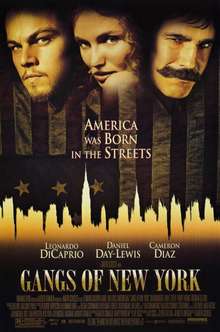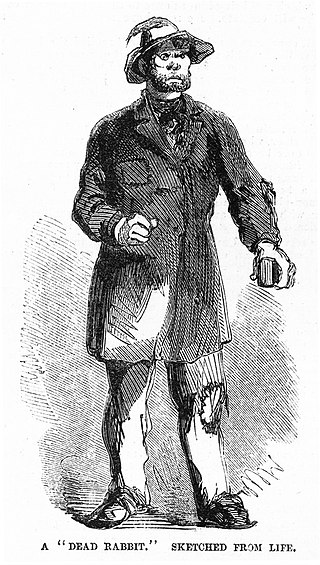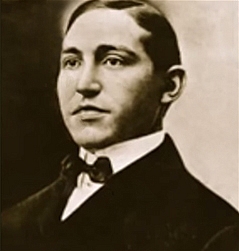
Five Points was a 19th-century neighborhood in Lower Manhattan, New York City. The neighborhood, partly built on low-lying land which had filled in the freshwater lake known as the Collect Pond, was generally defined as being bound by Centre Street to the west, the Bowery to the east, Canal Street to the north, and Park Row to the south. The Five Points gained international notoriety as a densely populated, disease-ridden, crime-infested slum which existed for over 70 years.

Gangs of New York is a 2002 American epic historical drama film directed by Martin Scorsese and written by Jay Cocks, Steven Zaillian, and Kenneth Lonergan, based on Herbert Asbury's 1927 book The Gangs of New York. The film stars Leonardo DiCaprio, Daniel Day-Lewis, and Cameron Diaz, along with Jim Broadbent, John C. Reilly, Henry Thomas, Stephen Graham, Eddie Marsan, Brendan Gleeson, and Liam Neeson in supporting roles. The film also marks the start of a fruitful collaboration between DiCaprio and Scorsese.

The Dead Rabbits were an Irish American criminal street gang active in Lower Manhattan in the 1830s to 1850s. The Dead Rabbits were so named after a dead rabbit was thrown into the center of the room during a gang meeting, prompting some members to treat this as an omen, withdraw, and form an independent gang. Their battle symbol was a dead rabbit on a pike. They often clashed with Nativist political groups who viewed Irish Catholics as a threatening and criminal subculture. The Dead Rabbits were given the nicknames of "Mulberry Boys" and the "Mulberry Street Boys" by the New York City Police Department because they were known to have operated along Mulberry Street in the Five Points.

The Bowery is a street and neighborhood in Lower Manhattan in New York City, United States. The street runs from Chatham Square at Park Row, Worth Street, and Mott Street in the south to Cooper Square at 4th Street in the north. The eponymous neighborhood runs roughly from the Bowery east to Allen Street and First Avenue, and from Canal Street north to Cooper Square/East Fourth Street. The neighborhood roughly overlaps with Little Australia. To the south is Chinatown, to the east are the Lower East Side and the East Village, and to the west are Little Italy and NoHo. It has historically been considered a part of the Lower East Side of Manhattan.
Bowery most prominently refers to a street and neighborhood in Lower Manhattan, New York City. It is an anglicization of Bouwerie, the archaic form of the Dutch for "farm", that was used in numerous New Netherland placenames.

The Forty Thieves — likely named after Ali Baba and the Forty Thieves — were formed in 1825 and alleged to be the first known and oldest New York City criminal street gang. The Thieves consisted primarily of Irish immigrants and Irish Americans who terrorized the Five Points neighborhood of 19th century Manhattan. Another criminal gang named the "Forty Thieves" which had no criminal ties to the New York gang was formed in London, England in 1828.

William Poole, also known as Bill the Butcher, was the leader of the Washington Street Gang, which later became known as the Bowery Boys gang. He was a local leader of the Know Nothing political movement in mid-19th-century New York City.

The Kerryonians were the second oldest criminal street gang in New York City but may have been the first gang in the city. The members were made up of recent Irish immigrants from County Kerry, Ireland. There was also a 19th-century Philadelphia gang of the same name. Beginning in the 1820s, the Kerryonians were part of the first wave of the early New York gangs, following behind the first and oldest gang in the city, the Forty Thieves, to occupy the Five Points area. The Kerryonians were particularly fond of targeting New Yorkers who were of British descent. The Kerryonians also fought a gang named the "Pelters". They are most known however for disrupting British actor William Charles Macready's performance at Astor Place around 1825. The Kerryonians were eventually absorbed into the growing street gangs of Five Points such as the Dead Rabbits, Roach Guards, and Chichesters.

The Shirt Tails were a mid-19th-century street gang based in the Five Points slum in Manhattan, New York, United States, who wore their shirts on the outside of their pants as 19th-century Chinese laborers would dress as a form of insignia and as a sign of gang group affiliation. Members kept their weapons—as many as three or four at a time—concealed beneath their shirts; this discreet measure stands in contrast to competing gangs who flaunted their weapons in order to intimidate.

The Chichesters also known as the Chichester Gang, along with the Forty Thieves, Shirt Tails, and Kerryonians, were one of the oldest early 19th century Irish Five Points street gangs during the mid 19th century in New York City. The Chichester Gang was organized by its founder John Chichester. The gang got their start by stealing from stores and warehouses and selling the stolen goods to local fences in the 1820s and later became involved in illegal gambling and robbery. An ally of the Dead Rabbits against the Bowery Boys, the Chichesters maintained between 50-100 members lasting for more than 50 years before being absorbed by the Whyos, much like many of the early gangs, following the American Civil War in 1865.

Paul Kelly was an Italian-born American mobster, who founded the Five Points Gang in New York City. He had started some brothels with prize money earned in boxing. Five Points Gang was one of the last dominant street gangs in New York history. Kelly recruited young, poor men from the ethnically diverse immigrant neighborhoods of Lower Manhattan. The Five Points Gang included some who later became prominent criminals in their own right, including Johnny Torrio, Al Capone, Lucky Luciano, Meyer Lansky and Frankie Yale.

The Five Points Gang was a criminal street gang, initially of primarily Irish-American origins, based in the Five Points of Lower Manhattan, New York City, during the late 19th and early 20th century.

The Whyos or Whyos Gang, a collection of the various post-Civil War street gangs of New York City, was the city's dominant street gang during the mid-late 19th century. The gang controlled most of Manhattan from the late 1860s until the early 1890s, when the Monk Eastman Gang defeated the last of the Whyos. The name came from the gang's cry, which sounded like a bird or owl calling, "Why-oh!"

The Bowery Boys were a nativist, anti-Catholic, and anti-Irish criminal gang based in the Bowery neighborhood of Manhattan, New York City in the early-mid-19th century. In contrast with the Irish immigrant tenement of the Five Points, the Bowery was a more prosperous working-class community. Despite its reputation as one of the most notorious street gangs of New York City at the time, the majority of the Bowery Boys led law-abiding lives for the most part. The gang was made up exclusively of volunteer firemen—though some also worked as tradesmen, mechanics, and butchers —and would fight rival fire companies over who would extinguish a fire. The Bowery Boys often battled multiple outfits of the infamous Five Points, most notably the Dead Rabbits, with whom they feuded for decades. The uniform of a Bowery Boy generally consisted of a stovepipe hat in variable condition, a red shirt, and dark trousers tucked into boots—this style paying homage to their fireman roots.
The Baxter Street Dudes was a New York City teenage street gang, consisting of former newsboys and bootblacks, who ran the Grand Duke's Theatre from the basement of a dive bar on Baxter Street in Manhattan during the 1870s. Led by founder Baby-Face Willie, gang members operated the Grand Duke's Theatre and established the venue as their headquarters. Members of the Baxter Street Dudes wrote and performed plays, musicals and variety shows which were enjoyed by other street toughs and slummers throughout the city. The theater house eventually became a popular underworld hangout, from which the gang found financial success.
Giovanni de Silvio or Jimmy Kelly was an American saloon keeper, political organizer and underworld figure in New York City during the start of the 20th century. He was the owner the Fourteenth Street saloon The Folly as well as the popular Mandarin Cafe in Chinatown, located in the notorious "Bloody Angle" along Doyers Street, and was a hangout for politicians, gang leaders and other noted criminals of the era. His cafe was also the scene of several violent incidents, especially during the Tong War, which included, in 1910, the fourth attempted suicide of Chinatown character John "Dippy" Rice and the 1912 murder of Hen Ken Yum, the latter a high-level member of the On Leong Tong and a lieutenant of Mock Duck.

The Dead Rabbits riot was a two-day civil disturbance in New York City evolving from what was originally a small-scale street fight between members of the Dead Rabbits and the Bowery Boys into a citywide gang war, which occurred July 4–5, 1857. Taking advantage of the disorganized state of the city's police force—brought about by the conflict between the Municipal and Metropolitan police—the fighting spiraled into widespread looting and damage of property by gangsters and other criminals from all parts of the city. It is estimated that between 800 and 1,000 gang members took part in the riots, along with several hundred others who used the disturbance to loot the Bowery area. It was the largest disturbance since the Astor Place Riot in 1849 and the biggest scene of gang violence until the New York Draft Riots of 1863. Order was restored by the New York State Militia, supported by detachments of city police, under Major-General Charles W. Sandford.

Gang colors include clothing, accessories, or tattoos of a specific color or colors that represent an affiliation to a specific gang or gang branch.
The Atlantic Guards were a 19th-century American street gang active in New York City from the 1840s to the 1860s. It was one of the original, and among the most important gangs of the early days of the Bowery, along with the Bowery Boys, American Guards, O'Connell Guards, and the True Blue Americans.












